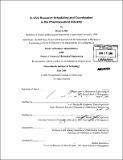In vivo research scheduling and coordination in the pharmaceutical industry
Author(s)
Hill, Brent A. (Brent Alan)
DownloadFull printable version (23.85Mb)
Other Contributors
Leaders for Manufacturing Program.
Advisor
Stanley B. Gershwin and Andreas S. Schulz.
Terms of use
Metadata
Show full item recordAbstract
(cont.) A multi-criteria objective function uses the researcher's preference to optimize both room assignments and procedure start time. A Tabu search meta-heuristic has been developed to generate a near-optimal solution. The solution approach uses four neighborhood move strategies based on insert and interval exchange algorithms to optimize procedural room assignments. Although a functioning model was not developed, a recommended implementation plan is discussed. The pharmaceutical industry is experiencing significant competitive pressures. Innovation productivity continues to decline, while the costs for drug R&D steadily rise. This project, sponsored by Novartis Institutes for BioMedical Research (NIBR), is intended to lower drug R&D costs and increase R&D process efficiency through improved research operations. This analysis focuses on improving the scheduling and coordination of early stage, in vivo drug discovery research projects within NIBR's animal facilities. Many of the communication processes used to coordinate research activities in these facilities use ad hoc methods for relaying critical information between research teams and the operations staff. Greater efficiencies can be achieved with the application of risk pooling concepts where dispersed research activities are brought together under a consolidated management structure. These efficiencies cannot be realized until the communication processes are improved. Integral to this improvement effort is the development of a fair and robust method for allocating in vivo resources to research projects using a centralized scheduling system. This thesis provides the framework for developing a centralized scheduling system. The architecture of this tool requires a web-based interface in order to provide seamless access to the research community. Based on research workflows, the proposed tool coordinates input from scientists and uses this information to schedule the required resources. The complex constraints found in a research animal facility dictate the need for a unique scheduling approach. Adapted from existing airline gate scheduling research, this problem is formulated as a mixed integer linear program.
Description
Includes bibliographical references (p. 89-90). Thesis (M.B.A.)--Massachusetts Institute of Technology, Sloan School of Management; and, (S.M.)--Massachusetts Institute of Technology, Dept. of Mechanical Engineering; in conjunction with the Leaders for Manufacturing Program at MIT, 2008.
Date issued
2008Department
Leaders for Manufacturing Program at MIT; Massachusetts Institute of Technology. Department of Mechanical Engineering; Sloan School of ManagementPublisher
Massachusetts Institute of Technology
Keywords
Mechanical Engineering., Sloan School of Management., Leaders for Manufacturing Program.